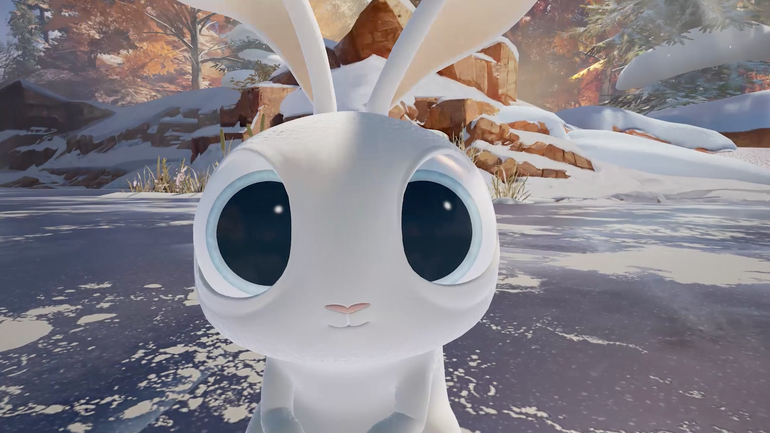Baobab Studios has been dubbed the “Pixar of VR,” which is quite a feat given the studio was just founded in 2015. But the startup already has a pair of VR animated shorts to its name, Invasion! and Asteroids! (which launches early next year) following the humorous relationship between a cute and fuzzy bunny and a pair of aliens. Those shorts, written and directed by ex-DreamWorks Animation writer/director Eric Darnell, have attracted the attention of both Hollywood and venture capitalists.
Baobab recently added $25 million from Twentieth Century Fox, Evolution Media Partners and Shanghai Media Group to its coffers. CEO of Baobab Studios, Maureen Fan, said this will allow the company to both expand its original IP and pull the trigger on some of the dozen new ideas co-founder Darnell is already developing. The studio raised $6 million last year from Comcast Ventures, HTC and Samsung to create its first two VR shorts using Epic Games’ Unreal Engine 4 technology.
Fan recently spoke at the VIEW Conference in Turin, Italy, where she revealed one of the new original VR projects in the works focuses on a germ’s journey through the human body. She talks about the creative freedom virtual reality is opening up and how video games and Hollywood creatives at Baobab are working together to define storytelling in this new medium in this exclusive interview.

What has virtual reality opened up creatively for your studio?
It’s a completely different medium from traditional 2D film, so we have to think about it completely differently. But at the same time, there are some things that are similar, which is that a great story is still at the heart of everything. I’d rather a great story be told with stick figures than a poor story told with beautiful graphics and photorealism. VR lets you put the viewer in that space and make them feel like they’re part of that story.
VR is very much in the early days, so everyone is experimenting. It’s too early to say what you can and can’t do. But the two parts of our first VR experience that audiences liked the most was when the bunny comes and sniffs you in the face and then starts playing with you. At first, Eric (Darnell) didn’t believe in the empathy thing because he thought it was a buzz word, but after that experience of people saying that they loved when the bunny came up and sniffed them, he changed his mind. People would start trying to pet the bunny, coo at the bunny and start playing on the ground with the bunny as though it were actually reacting to them. Just think about Mickey Mouse. If he’s actually in that room with you interacting with you, how much more real does that character become, how much more do you care about that character? So, the ability to make you care more about the character means that you care more about the story and what happens to that character.
How did you set up your studio to draw from both video games and traditional Hollywood entertainment?
My background is mostly in games. I did do film as well, working on The Dam Keeper and Toy Story 3, but the majority of my career was at Zynga focusing on casual gaming. So, I very much come from that mindset of slightly less production value, but it’s about the interactivity on the screen and the story of you as a character. Both Larry Cutler and Eric Darnell, my two co-founders, came from the film side, which is a very different way of thinking. Even from a project management style, film uses more of a waterfalls process and product management versus games, which are more agile and a daily scrub. So converging those two has been interesting because our team also reflects that split between people from the game industry and from the film industry. And in some cases, we have unicorns—people who are from the film industry and then moved to the game industry. Having both really helps because VR is a medium that’s not necessary only film or games, but oftentimes it can be both. At least that’s what we are trying to do. It’s a narrative experience like film, but it’s in a real-time game engine. You are a character inside our first two VR experiences, to it’s also somewhat the story of you. But we want you to care about the other characters more than in a game. It blurs the lines, so we needed talent from both sides.
What do you feel separates your interactive films from video games?
Eric feels that the majority of games are about you and your ego. When you perform actions in games you often think about what the game maker wants me to do. There’s a bit of self-consciousness in there and there’s always a goal. Eric wants you to act because you care about these characters. You want to make the character happy or you want to help the character, but it feels slightly different than the majority of the games because you’re not acting in self-interest. Instead, you’re acting out of compassion and care for this other character. With the game controller, it always feels like there’s an interface between you and this world, but now in VR, you just act like a normal human being using your normal gestures and you feel like it’s real life. Just think about how amazing it will be when you don’t have to push a button or do anything, you could just be yourself. At that point, you are a character in the experience rather than an actor or an avatar inside that experience.
How much interactivity do viewers want in a narrative experience that’s not a game?
I think the jury is still out because it’s mostly early adopters who are using VR, especially with the high-end headsets. They’re gamers who are used to interactivity and love it, but I’m not convinced that everybody wants [entertainment] to be interactive when they come home from a long day at work. Many people just want to sit on their couch and be able to experience things passively. So, there’s a balance to be had between those, which is why I think 360 video is actually the most popular form on mobile headsets rather than a lot of the games and interactive experiences. That being said, I do believe that interactivity does take you there even more. VR is about putting you in that space and giving you some agency and control in that space. Interactivity adds even more to that sense of presence.
What do the Oculus Touch and the HTC Vive controllers open up for storytelling?
In Invasion!, you have your little bunny body, so you realize that you are a character in there and people were delighted by that. Many people spent the first session of the experience, especially kids, of just looking at their bunny bodies and squatting up and down and hopping around the room like a bunny. And then they would want to watch the experience again because they just love the story. People absolutely loved it, and it does add some depth to the experience and explains why these other characters interact with you.
What did you learn even going from Invasion! to Asteroids! in terms of what people were looking for?
They loved being the character and being able to interact with other characters. Even when the other characters aren’t actually running in the real-time game engine and interacting with you, they still had that emotional response. On the high-end headsets they’re fully interactive, but our mobile version is pre-rendered 360 all around. And even these people still believed that the bunny was interacting with them. Those are the most powerful moments—when they bond with the other characters.
What potential do you see for video games with Invasion!?
Our IP can go everywhere because it’s a great story. I know a lot of Hollywood companies actually wanted to turn Farmville into a TV show and a movie. At DreamWorks, where Eric is from, they’ve now turned a lot of their movies into TV shows and video games like How to Train Your Dragon and Minions. So, I definitely see that as a possibility for the future. If people love those characters, the story and that world, that’s when it opens up a ton of possibilities.

